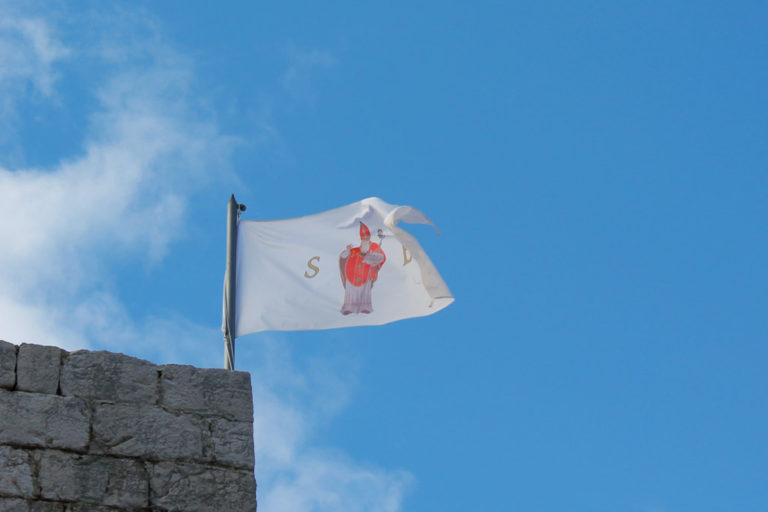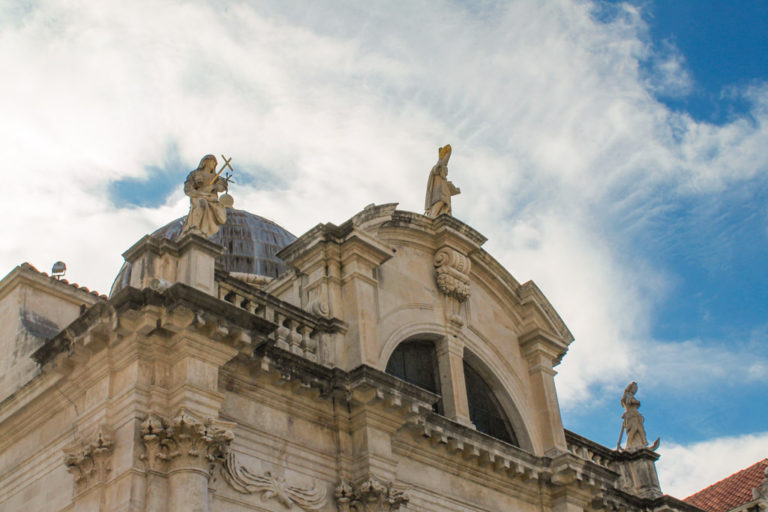Saint Blaise, Dubrovnik’s Patron Saint
Many cities have their patron saints, but only Saint Blaise has its city. This is a saying that we often hear about Dubrovnik’s patron saint—Saint Blaise.
Wandering through the streets of Dubrovnik’s old town, you’ll find it impossible to escape the vigilant gaze of the city’s heavenly advocate.
As many as twenty statues of Saint Blaise greet us from the city walls, its main entrances, and its most important public and church buildings.
His pictures are featured on Dubrovnik Republic’s official flag, old state coins, seals, and medals.
His church adorns the city’s main public square.
The traditional celebration on his feast day, held in Dubrovnik every year on February 3, was inscribed on the UNESCO’s Intangible Cultural Heritage list in 2009.
So who was Dubrovnik’s Patron Saint, Saint Blaise? And why is there such a deep connection between him and the people of Dubrovnik?
Life of Saint Blaise
Saint Blaise is told to have been born around 280 A.D. in the province of Small Armenia. He became bishop of Sebasta (the present city of Sivas in Turkey).
He studied medicine and healed both people and animals. He retreated to the mountains and lived in a cave, surrounded by wild animals.
He died as a martyr in 316.
His most famous miracles are connected to his gift of healing.
He is told to have saved a boy, who was choking on a fishbone. That’s why he is invoked for protection against throat diseases.
Another story tells of a poor woman whose piglet was seized by a wolf. She came to Saint Blaise asking for his help. At his command, the wolf let the piglet go.
The cult of Saint Blaise is widespread all around the world. Only in Italy, there are more than five hundred churches and chapels that bear his name. Together with Saint Nicholas, he is the saint equally venerated both in the Western and Eastern Church.

The official flag of the ancient Republic of Dubrovnik with the image of Saint Blaise
Saint Blaise and Dubrovnik—the legend
The year is 971.
The mighty Venetian navy stop in Dubrovnik to get supplies of food and water on their way to the Levant. However, secretly at night, fifteen nights in a row, they try to conquer the city.
Saint Blaise, sent by God himself, appears to priest Stojko and warns him of the enemies. He says they pretend to be friends at day, and they try to seize the city at night.
He continues by explaining how he, leading the celestial army, was pushing the enemy back every night. He advises priest Stojko to inform the Dubrovnik government of the Venetian plans to attack the city. When priest Stojko asks him about his identity, he states his name is Saint Blaise.
Thanks to his help, the people of Dubrovnik manage to defend the city, and the Venetians sail away.
And, the deep connection and love between the people and their protector is born.

The statue of Saint Blaise above the Ploče gate in the old town

The smallest statue of Dubrovnik’s Patron Saint, Saint Blaise, situated in the old harbor
The feast day of Saint Blaise in Dubrovnik
It is believed that, by the middle of the 12th century, Saint Blaise would have been instituted as the Dubrovnik’s Patron Saint.
Every year in February, and as early as in 1190, the city of Dubrovnik gets in a special festive mood.
The traditional celebration starts with the opening of the festivity on February 2, the Feast of Candlemas.
The opening ceremony is held in front of Saint Blaise’s church. During the ceremony, two white doves, symbols of peace, are released, and the traditional white flag with the image of Saint Blaise is raised.
After, the worshippers flow to the church of Saint Blaise to get their throats blessed through his intercession.
On the very feast day, February 3, people from the whole Dubrovnik region and wider gather in the city.
After a solemn mass, a magnificent procession starts, representing the most impressive part of the festivity.
The procession is headed by bishops and priests, who carry reliquaries of Saint Blaise. After them, follow worshipers, wearing traditional folk costumes and walking behind their parish banners. A colorful display of culture and traditions!
Saint Blaise’s church in the old town of Dubrovnik

In the main square of the old town stands one of the most impressive Dubrovnik churches, built in the honor of its beloved patron saint.
It’s a work of the Venetian sculptor Marino Groppelli, and was built from 1706 to 1715 in the Baroque style.
Its upper part is adorned with three figures.
In the middle is the statue of Saint Blaise, dressed in bishop’s attire, wearing an episcopal mitre (hat) on his head. He is grasping the bishop’s staff in one hand, and the model of the old town in the other.
Next to him, on both sides, are the statues of two women, representing virtues—faith with a cross and chalice, and hope with an anchor.
The interior of the church is no less impressive.
Particularly stands out the main altar (1748), which shelters a small gilded silver statue of Saint Blaise from the 15th century.
The statue is said to have miraculously survived the fire of 1705. The fire almost entirely destroyed the older Romanesque church of Saint Blaise, which was built on the same spot in 1348.
Behind the main altar is situated the choir loft (gallery), with the organs dating from 1720. The gallery is embellished with five paintings of Petar Mattei, a Dubrovnik born painter.
The paintings include the depiction of Saint Cecilia, the patroness of music and musicians, and king David.
The main painting depicts the martyrdom of Saint Blaise, while the two other paintings depict angels. The angels carry attributes of Saint Blaise, his bishop’s insignia: episcopal mitre, crozier, and crown, and symbols of his martyrdom: palm branch, iron comb, and whip.
There existed a third, the oldest church of Saint Blaise. Even though its original location was a matter of dispute, most historians believe it was situated within the city walls, close to the west city entrance.
Did you know?
The franchise (freedom) of Saint Blaise was instituted first in 1190.
It consisted of the Government promising to allow all debtors exiled from Dubrovnik’s Republic to freely come to the city three days prior and three days after the feast of Saint Blaise (a week in total).
In this period, they were allowed to seek arrangements and settle the debts with their creditors, without any legal consequences.
